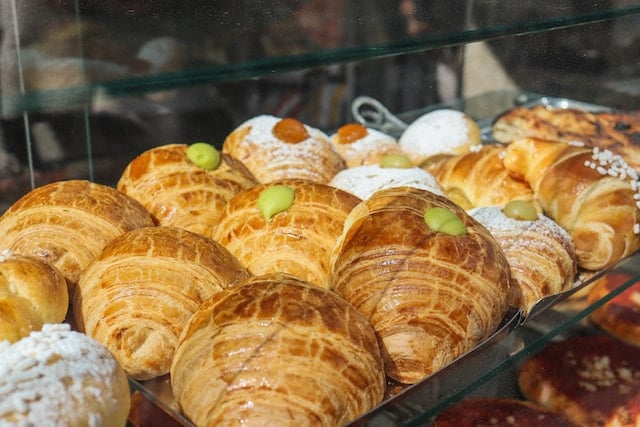Italian pastries: Is it a cornetto, croissant or brioche?

The classic Italian breakfast is loved across the country - but what should you call the pastry you order with your cappuccino? Here's why the name seems to change depending on where you are, and what the difference actually is.
There are plenty of differences between Italy’s northern and southern regions, and one you might have noticed is that the daily breakfast pastry served (and quickly devoured) along with a frothy cappuccino at the local bar-pasticceria might have a different name depending on where you go.
READ ALSO: Where, when and how to drink coffee like an Italian
Most people will probably know it as a cornetto, which is something many visitors to Italy mistake for a croissant.
Google translates cornetto as croissant most of the time, which doesn’t help matters. And Italians themselves might even call it a croissant (pronounced 'crassant') if ordering at a fancier type of pasticceria, when they’re feeling a bit fancy themselves.
Meanwhile, some bars and bakeries advertise a brioche. But can it be a brioche if it’s shaped like a cornetto? Is there always a difference, or just sometimes? And does it really matter what you call it?
Let's have a look at what's going on.
North vs south
Generally speaking, a cornetto is called a cornetto in the centre and south of Italy, while the exact same pastry is usually referred to as a brioche in northern regions.
In fact, some northern Italians may tell you they've never heard anyone order a cornetto.
According to popular Italian food blog Dissapore: “In Italy it is called brioche in the north and cornetto in the centre-south: a cultural heritage that has little to do with the actual characteristics of these sweets.”
“Italy seems to be the undisputed homeland of the binomial 'cappuccino and cornetto/brioche,'” it notes.
🇮🇹 Cornetto or brioche? 🥐 What does your local bar call Italy's most popular breakfast pastry - and do you know what the difference is? https://t.co/GxHEDMo8ef
— The Local Italy (@TheLocalItaly) May 29, 2023
Alessandro Pirollo, a writer at Italy's esteemed food magazine La Cucina Italiana, goes a step further by saying: "calling [a cornetto] a brioche is just an improper use of the term, widespread in northern Italy."
"True brioche is different from a cornetto, but be warned: neither one is a croissant," he writes.
Shape, texture and ingredients
Each pastry has a long and disputed history, and their ingredients differ.
Croissants are known for their buttery flavour, which comes through because of the absence of egg in the mixture, explains Pirollo. This also accounts for its "flakier, lighter" texture.
“The brioche and cornetto have more in common from this point of view," says Dissapore.
"The same ingredients but different methods, as the brioche is leavened and the cornetto is layered with butter. They both contain flour, a lot of butter, a lot of sugar, yeast, eggs and milk."
Repitan conmigo: Cornetto, Croissant y Brioche NO SON LO MISMO, Y LA DIFERENCIA TAMPOCO ES LA TRADUCCIÓN DEL FRANCÉS AL ITALIANO O VICEVERSA!! Las diferencias son: los ingredientes y la forma. Dependiendo de la zona, se consume una más que otra. pic.twitter.com/atZEpUbNkN
— raul cubilla (@raul_cubilla) January 4, 2023
For the brioche, notes Dissapore, “lard may also be used instead of butter”.
To muddy the waters further, in many parts of the south cornetti are also made using lard (strutto) instead of butter. (In fact, quite a few southern Italian pastries are made using lard, including more traditional versions of the pasticciotto and sfogliatella.)
The texture and shape of the pastry is probably the easiest way to tell them apart.
The brioche is soft and airy with a rounded shape, often topped with a ball of dough. In Sicily this is called a brioche col tuppo and it's often served either filled with or soaked in granita or gelato.
Ragazzi, ora basta. Credo di poter dire la parola definitiva: #brioche è quella rotonda col "tuppo" (vedi foto), magnifica con la granita di fragole o caffè con panna o con il gelato, #cornetto è quello con due punte, farcito o no. Fidatevi. Firmato: la Crusca della Brioche pic.twitter.com/Jx6RCgUbOl
— Mangino Brioches (@manginobrioches) June 21, 2019
A cornetto and a croissant may be fairly similar in appearance, at least to the untrained eye, but the cornetto is usually straighter while a croissant is curled.
Cornetti are also crunchier, less sweet, and can be eaten plain, though you'll often find them served already filled with chocolate, cream, or jam.
READ ALSO: French dilemmas: Is it a pain au chocolat or a chocolatine?
Usually, at least in France, croissants are not filled with cream or chocolate.

Cornetti for sale in Naples. Photo by Nicole Arango Lang on Unsplash
There are countless articles and blog posts written in Italian on the cornetto vs brioche vs croissant debate, which suggests that there's widespread confusion about the differences even among Italians themselves.
The north-south debate over what to call the standard Italian breakfast pastry is also frequently the subject of jokes on Italian social media.
Voi questo come lo chiamate? Brioche o cornetto?
Cc @AndreC198 pic.twitter.com/HwVvN4DYGy
— Cesira la Talpa (@il_Maggiore) June 4, 2021
Whatever you call it, another important north-south difference is that in the south, hot cornetti, invariably made using lard, are not only eaten for breakfast but also served up to hungry customers as a late-night snack - meaning it's not unusual to see long queues outside of bakeries at 1am on summer nights everywhere from Bari to Rome.
Meanwhile in the north of Italy, breakfast is the only time you'll see anyone eating a cornetto. Or should that be brioche?
Comments (1)
See Also
There are plenty of differences between Italy’s northern and southern regions, and one you might have noticed is that the daily breakfast pastry served (and quickly devoured) along with a frothy cappuccino at the local bar-pasticceria might have a different name depending on where you go.
READ ALSO: Where, when and how to drink coffee like an Italian
Most people will probably know it as a cornetto, which is something many visitors to Italy mistake for a croissant.
Google translates cornetto as croissant most of the time, which doesn’t help matters. And Italians themselves might even call it a croissant (pronounced 'crassant') if ordering at a fancier type of pasticceria, when they’re feeling a bit fancy themselves.
Meanwhile, some bars and bakeries advertise a brioche. But can it be a brioche if it’s shaped like a cornetto? Is there always a difference, or just sometimes? And does it really matter what you call it?
Let's have a look at what's going on.
North vs south
Generally speaking, a cornetto is called a cornetto in the centre and south of Italy, while the exact same pastry is usually referred to as a brioche in northern regions.
In fact, some northern Italians may tell you they've never heard anyone order a cornetto.
According to popular Italian food blog Dissapore: “In Italy it is called brioche in the north and cornetto in the centre-south: a cultural heritage that has little to do with the actual characteristics of these sweets.”
“Italy seems to be the undisputed homeland of the binomial 'cappuccino and cornetto/brioche,'” it notes.
🇮🇹 Cornetto or brioche? 🥐 What does your local bar call Italy's most popular breakfast pastry - and do you know what the difference is? https://t.co/GxHEDMo8ef
— The Local Italy (@TheLocalItaly) May 29, 2023
Alessandro Pirollo, a writer at Italy's esteemed food magazine La Cucina Italiana, goes a step further by saying: "calling [a cornetto] a brioche is just an improper use of the term, widespread in northern Italy."
"True brioche is different from a cornetto, but be warned: neither one is a croissant," he writes.
Shape, texture and ingredients
Each pastry has a long and disputed history, and their ingredients differ.
Croissants are known for their buttery flavour, which comes through because of the absence of egg in the mixture, explains Pirollo. This also accounts for its "flakier, lighter" texture.
“The brioche and cornetto have more in common from this point of view," says Dissapore.
"The same ingredients but different methods, as the brioche is leavened and the cornetto is layered with butter. They both contain flour, a lot of butter, a lot of sugar, yeast, eggs and milk."
Repitan conmigo: Cornetto, Croissant y Brioche NO SON LO MISMO, Y LA DIFERENCIA TAMPOCO ES LA TRADUCCIÓN DEL FRANCÉS AL ITALIANO O VICEVERSA!! Las diferencias son: los ingredientes y la forma. Dependiendo de la zona, se consume una más que otra. pic.twitter.com/atZEpUbNkN
— raul cubilla (@raul_cubilla) January 4, 2023
For the brioche, notes Dissapore, “lard may also be used instead of butter”.
To muddy the waters further, in many parts of the south cornetti are also made using lard (strutto) instead of butter. (In fact, quite a few southern Italian pastries are made using lard, including more traditional versions of the pasticciotto and sfogliatella.)
The texture and shape of the pastry is probably the easiest way to tell them apart.
The brioche is soft and airy with a rounded shape, often topped with a ball of dough. In Sicily this is called a brioche col tuppo and it's often served either filled with or soaked in granita or gelato.
Ragazzi, ora basta. Credo di poter dire la parola definitiva: #brioche è quella rotonda col "tuppo" (vedi foto), magnifica con la granita di fragole o caffè con panna o con il gelato, #cornetto è quello con due punte, farcito o no. Fidatevi. Firmato: la Crusca della Brioche pic.twitter.com/Jx6RCgUbOl
— Mangino Brioches (@manginobrioches) June 21, 2019
A cornetto and a croissant may be fairly similar in appearance, at least to the untrained eye, but the cornetto is usually straighter while a croissant is curled.
Cornetti are also crunchier, less sweet, and can be eaten plain, though you'll often find them served already filled with chocolate, cream, or jam.
READ ALSO: French dilemmas: Is it a pain au chocolat or a chocolatine?
Usually, at least in France, croissants are not filled with cream or chocolate.

There are countless articles and blog posts written in Italian on the cornetto vs brioche vs croissant debate, which suggests that there's widespread confusion about the differences even among Italians themselves.
The north-south debate over what to call the standard Italian breakfast pastry is also frequently the subject of jokes on Italian social media.
Voi questo come lo chiamate? Brioche o cornetto?
— Cesira la Talpa (@il_Maggiore) June 4, 2021
Cc @AndreC198 pic.twitter.com/HwVvN4DYGy
Whatever you call it, another important north-south difference is that in the south, hot cornetti, invariably made using lard, are not only eaten for breakfast but also served up to hungry customers as a late-night snack - meaning it's not unusual to see long queues outside of bakeries at 1am on summer nights everywhere from Bari to Rome.
Meanwhile in the north of Italy, breakfast is the only time you'll see anyone eating a cornetto. Or should that be brioche?
Join the conversation in our comments section below. Share your own views and experience and if you have a question or suggestion for our journalists then email us at [email protected].
Please keep comments civil, constructive and on topic – and make sure to read our terms of use before getting involved.
Please log in here to leave a comment.